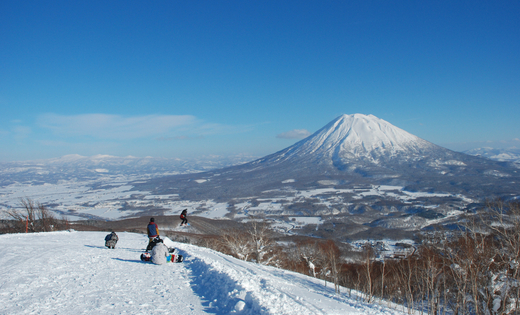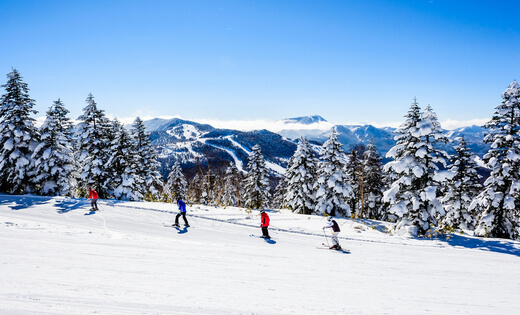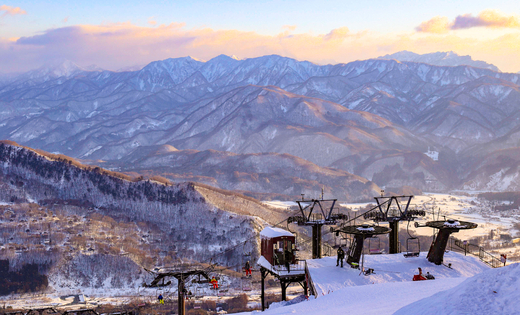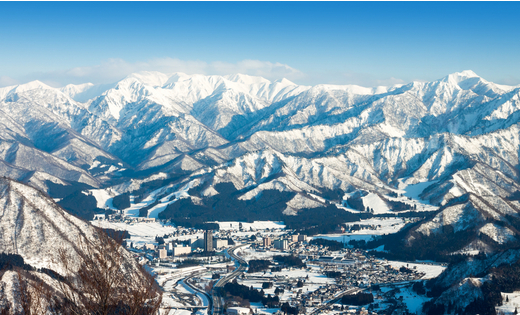You'll find most mountains (and snow) on the islands of Honshu and Hokkaido. There are literally hundreds of resorts to choose from. We've narrowed it down to five destinations that cater to every type of skier. Whether you're after heli-skiing, cross country skiing, tree skiing, exploring the backcountry, or gentler — but indisputably beautiful — beginner's terrain, you'll find it here.

At Niseko United, you get four Hokkaido ski resorts on one mountain: Grand Hirafu, Niseko Annupuri, Niseko Hanazono, and Niseko Village.
Each resort has its own character — some buzzing with activity, others offering a quieter, more mellow experience, with traditional lodgings.
There's terrain for beginner, intermediate and experienced skiers, as well as the opportunity for night skiing, heli-skiing, and backcountry skiing.
All offer easy snow access and a range of kid-focussed activities — Kids Land Annapurni, the Hanazono Tube Park, the newly opened Niseko Grand HIRAFU Kids Park, and the creative Kids Snowsports School. There are even kid-sized snowmobiles that staff will teach your kids to ride.
Children 0-6 years ski free, and childcare is available for 1-6 year-olds. Lessons for all ages are available in English.
The cheapest way from Tokyo to Niseko is to fly, but you can also take the Shinkansen bullet train. Additionally, if you're travelling elsewhere in Japan, a JR Pass is worth investing in.

What could be more beautiful than combining hot springs under the stars, a remote location in a national park, and great skiing? Manza Onsen is a town high on the slopes of Mount Shiran, on the island of Honshu. The onsens here reportedly have among the highest levels of sulphur of any in Japan.
The ski runs are mainly beginner to intermediate, but there's also a terrain park and backcountry skiing on offer. It's four hours by train from Tokyo, but if you're as much about the journey as the destination, you can ski there from Shiga Kogen, one of Japan's largest ski areas.
Manza Onsen is small and quiet, and not overrun with Western tourists. If you’re after some alone time, this is the ideal location.
If that sounds a bit confronting, then you're better off heading to the larger, more accessible Nozawa Onsen. This UNESCO world heritage site, listed for its unique gassho style housing, is becoming a promising backcountry skiing destination. Right now, it’s still relatively unknown, so your experience of this picturesque mountain is likely to feel private and exclusive.
Located at the foot of Mount Hakusan in the Northern Japanese Alps, there are no mechanised lifts from the valley, so you'll need a good fitness level, as well as the services of an experienced guide to make the most of it.
Your hard work will be rewarded by steep, deep, untracked powder, and long runs that aren’t overrun by crowds.
Round off your adventure by exploring the traditional culture and cuisine of the local villages.

This UNESCO world heritage site, listed for its unique gassho style housing, is becoming a promising backcountry skiing destination. Right now, it’s still relatively unknown, so your experience of this picturesque mountain is likely to feel private and exclusive.
Located at the foot of Mount Hakusan in the Northern Japanese Alps, there are no mechanised lifts from the valley, so you'll need a good fitness level, as well as the services of an experienced guide to make the most of it.
Your hard work will be rewarded by steep, deep, untracked powder, and long runs that aren’t overrun by crowds. Round off your adventure by exploring traditional culture and cuisine of the local villages.

Hakuba Valley is at the base of the Northern Alps. There are 10 resorts altogether, all connected by shuttle bus.
There are two well-known resorts: Happo-One and Cortina. If Happo-One sounds familiar, that's because of the Nagano winter Olympic games in 1998.
In addition to great skiing, Hakuba offers proximity to cultural experiences and opportunities for exploration.
When you've had enough of the slopes, take a day trip to see the famed Japanese snow monkeys in Jigokudani Koen “Hell Valley Park” (named for the volcanic activity). You can try your hand at Otari Taiko drumming, or learn about tea ceremonies and traditional clothing known as Yakuta.
It's also easy to find Hakuba accommodation in very close proximity to the Hakuba gondola, taking the hassle out of trekking to chairlifts.
It can take as little as 3 hours to get from Tokyo to Hakuba — 90 minutes by bullet train to Nagano, and then a local train to Hakuba station. Both resorts offer a discounted ski pass for seniors.

Sometimes plans change. If you suddenly find yourself with a spare 24 hours and an urge for snow, board the fast train from Tokyo to Gala Yuzawa. It only takes only 75 minutes, and Gala Yuzawa conveniently has its own Shinkansen (bullet train) station.
No equipment? No problem. You can rent everything you need. Pick up your tickets, take a lesson at the English language ski school, grab some food and head up on the gondola...it’s too easy!
Convenience brings crowds, of course, but the lines move quickly, and before you know it you're on the slopes. Beginner areas can be very crowded, but if you can move further up, you'll escape the queues. Plus, it’s generally quieter mid-week.
The cheapest, but not the best time to go skiing in Japan. Still, you might find decent snow at Okutadami Maruyami, which tends to close in the middle of the ski season because there's too much snow in peak season.
Expensive and crowded. You’ll need to book everything in advance.
January is sometimes called “Japanuary,” because there is so much snow, the temperature drops, and there’s not much sun. Remember that Chinese New Year falls in January or February, and so it’ll be more expensive to book around that time.
Spring skiing! More sunny days, it’s a little cheaper than December and January, and it’s the best time for beginners.
Temperatures are staying above 0 degrees. Sunny days. Locals are skiing in t-shirts. If you book outside school holidays, you could get some true bargains.
Christmas period, Chinese New Year. It’s expensive and crowded at this time of the year.

One of the greatest thing about skiing in Japan is the courier services that transport your ski gear from A to B. You can get to your destination by train or car, and your gear will likely be there before you.

If you want to ski check the rules. Where and where not to ski are strictly adhered to in Japan. PLUS! you won't be covered by your travel insurance if you ski off piste outside resort boundaries. See PDS for full terms.

Tipping is simply not part of the culture. In some restaurants you may be surprised with a small appetizer you didn't order, but are still expected to pay for (called otoshi), but this isn't always the case either.

Looking forward to an onsen to soothe those aching muscles? Many public onsen have an unofficial ban of tattoos. So if you have one, you'll need to reseach or opt for kashikiri-buro (private baths).

In some places you can be a little noisy in queues and on chairlifts, but in Japan it’s impolite to cause any discomfort to other guests. So, keep the volume low.


These are quite high risk when you go to the snow. You need to be educated about how to stay as safe as possible in the event of one because they can be deadly. Always read avalanche reports wherever you’re staying.

This could happen anywhere in Japan, but when you go to the snow, the big one to remember is that you can’t wear bathers/swimmers in an onsen. There’s a culture and ritual to using onsens - but that’s what makes it so much fun.

People have to be rescued more often than you'd think, and 9 in 10 people rescued from the Japanese ski fields are Australian.This is not covered by insurance, so be careful whenever going off-piste.